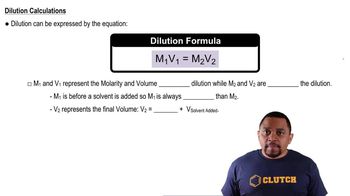Textbook Question
A 1.0-L buffer solution initially contains 0.25 mol of NH3 and 0.25 mol of NH4Cl. In order to adjust the buffer pH to 8.75, should you add NaOH or HCl to the buffer mixture? What mass of the correct reagent should you add?
 Verified step by step guidance
Verified step by step guidance


A 1.0-L buffer solution initially contains 0.25 mol of NH3 and 0.25 mol of NH4Cl. In order to adjust the buffer pH to 8.75, should you add NaOH or HCl to the buffer mixture? What mass of the correct reagent should you add?
In analytical chemistry, bases used for titrations must often be standardized; that is, their concentration must be precisely determined. Standardization of sodium hydroxide solutions can be accomplished by titrating potassium hydrogen phthalate (KHC8H4O4), also known as KHP, with the NaOH solution to be standardized. b. The titration of 0.5527 g of KHP required 25.87 mL of an NaOH solution to reach the equivalence point. What is the concentration of the NaOH solution?